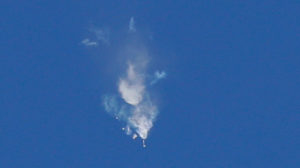Oct
14
NASA Woes and Jet Hijinx: A Series of Unfortunate Events
Have you heard of the book series A Series of Unfortunate Events by Lemony Snicket? From the summary in the Wikipedia entry:
“After their parents’ death in a fire, [three] children are placed in the custody of a murderous relative, Count Olaf, who attempts to steal their inheritance and, later, orchestrates numerous disasters with the help of his accomplices as the children attempt to flee. As the plot progresses, the Baudelaires gradually confront further mysteries surrounding their family and deep conspiracies involving a secret society known as V.F.D., with connections to Olaf, their parents, and many other family relatives.”
The events I have in mind for this week’s post aren’t nearly as entertaining, but the (possible) connections and strange timing of them all could make one suspicious of sinister conspiracies on the global stage…. Or, not.
First, last week deputy mission head Rachel Osten confirmed that another of the Hubble Space Telescope’s six gyroscopes failed, causing the aging machine to go into “safe mode”. The gyroscopes sense rotation and stabilize the telescope, and it needs at least three to be in working order to continue “normal operations”. This was the last of its three older gyros and had been 6 months overdue for replacement.
“NASA Goddard and Space Telescope Science Institute scientists are attempting to turn another of the newer gyros back on, but it’s acting squirrelly…. If only two gyroscopes remain, the Hubble team will operate the telescope using only one, in order to maximize the possible observing time.”
The HST will remain in safe mode for “a little while” as a thorough investigation is conducted.
Then, NASA reported that the Chandra X-ray Observatory entered “safe mode” on Wednesday. One of the most powerful telescopes in the world, Chandra tracks black holes, galaxies, supernovas, high-temperature gases, and quasars. It is only 19 years old, compared to Hubble’s 28 years, but Chandra is also far surpassing its original 5-year life expectancy. The occasional component malfunction isn’t surprising, but it is interesting that it appears this was also the result of a faulty gyroscope.
According to NASA, “All systems functioned as expected and the scientific instruments are safe.” The investigators expect to give a status update by Monday (i.e., tomorrow).
NASA isn’t the only space agency having issues.
“Early [Thursday], a Soyuz-FG booster rocket with a crewed Soyuz MS-10 spacecraft on top experienced a serious malfunction about three minutes into the flight, forcing U.S. astronaut Nick Hague and Russian cosmonaut Alexey Ovchinin to make an emergency landing in the Kazakh steppe. Both are reported to be in “good condition,” but the same cannot be said for the rocket, which crashed around 25 miles (40 kilometers) from the city of Zhezkazgan in the Karaganda Region of Kazakhstan.
It’s the first incident of its kind for Roscosmos — Russia’s space agency — since the fall of the Soviet Union. In response, Russian officials have suspended all crewed launches pending a review of the booster rocket failure. A criminal probe is also underway to determine if safety regulations were violated during construction. To that end, a Russian government Investigative Committee is inspecting the launch site and seizing documents, AFP reports.”
The problem for the U.S. (and the rest of the world) is that, with our Space Shuttle program decommissioned, Russian rockets have been the only way to get astronauts and supplies to the International Space Station (ISS). (Private-sector efforts won’t be ready until at least sometime in 2019, and the Chinese — which NASA is forbidden from working with, anyway — don’t have a manned flight scheduled until 2020.)
The ISS’s current trio of inhabitants — one each from NASA, ESA, and Roscosmos — are fully stocked with food and water, should they need to extend their stay until January. (It was unclear to me how they might get home after that, though, if the Russians still have crewed launches suspended.) While the station can be kept operational for quite awhile via ground control, there are multiple scientific experiments onboard that require personal attention from scientists. Plus, there are the inevitable maintenance-type issues, both mechanical and electronic, that may require human intervention on-site, as well.
Preliminary analysis of the incident points to a section from the booster’s first stage colliding into the second stage during the flight, possibly caused by “the failure of the system of the normal separation, which should have been activated.” Roscosmos seems optimistic, but it’s quite possible that the investigation, repairs, and any operational changes might take awhile. In other words, it may be a few months or more before any crewed missions are scheduled, which means some scientific experiments on the ISS could be ruined. As disappointing (and expensive) as that may be, safety of our astronauts & cosmonauts must come first, of course.
Meanwhile, back on the Earth…
You may have heard that an F-35 jet crashed late last month at Marine Corps Air Station Beaufort (South Carolina), apparently the result of a faulty fuel tube. Fortunately, the pilot was able to eject safely. Now, we are told that the U.S. military has temporarily grounded all of its F-35s — 240+ in total — and 11 international partners with F-35s are doing so, as well.
“[A] fleet-wide inspection of all F-35s overseen by a Navy aircraft mishap board was expected to be completed within the next couple of days, a Pentagon spokesperson said Thursday, and any suspect fuel tubes would be replaced.”
It is worth noting that the F-35 program has had several “deficiencies and problems” over the years, resulting in schedule delays and cost overruns. However, a spokesperson says the Pentagon is not reconsidering its relationship with Lockheed Martin, the defense contractor that makes the F-35, at this time.
Finally, the Belgian Air Force had its own bit of excitement this past week. It seems that a maintenance technician was working in an F-16AM jet at the Florennes Air Base, one of several being serviced ahead of a training mission, when he somehow accidentally activated the loaded, six-barreled Vulcan M16A-1 cannon. The Gatling-style rotary gun unleashed a hailstorm of bullets on a nearby F-16AM, hitting its fully fueled tank and… KA-BOOM! The exploding jet was a complete loss and another jet (possibly the one that fired) acquired some damage, as well. Yikes!
“Unfortunately, two technicians were also injured during the blast. The full extent of their injuries isn’t known, but the Belgian Aviation Safety Directorate has opened an investigation to see what, exactly, they can do to make sure something like this doesn’t happen again, possibly with even worse results.”
If it weren’t so serious, it might sound like something from a sit-com.
So, what do we make of all this?
If I were the conspiracy-theory type, I might wonder if these events were connected. Who might be responsible? Who’d have the power? Who threatened or paid off whom? Who would benefit? Why now? Or, maybe these are just cover stories for something else, something more nefarious. Multi-government conspiracy? Maybe an extra-governmental cabal? Are there alien overlords involved? What aren’t they telling us? Etc.
But, I’m not that type and try not to think that way, especially without waaaaaay more information. It’s more likely that these are unconnected events, except for the fact that there is a lot of old tech being used, both by space agencies and defense departments, unfortunately. Stuff is bound to break down, and in fact there are reports every year of computer glitches and failed components and other such things in various government projects and facilities. Of course, new tech also experiences issues that (hopefully) get ironed out turning testing but sometimes aren’t discovered until after it has gone “into production”. (Any of you had a “factory recall” on your vehicle?) I’m sure there are more glitches that happen that we don’t hear about. No use freaking out the public, right? (And, yes, we should be somewhat worried about outdated tech, while at the same time our enemies hack our current tech.) And, then, there is the case of the hapless Belgian maintenance technician….
So, I doubt these incidents are evidence of any sinister master plan, and the timing is likely just coincidental. On the other hand, it might make for a fun novel or movie plot. I wonder if Chris Carter is looking for ideas for a new season of “The X-Files”….


















